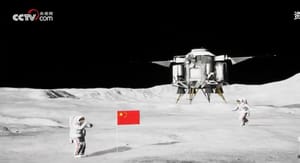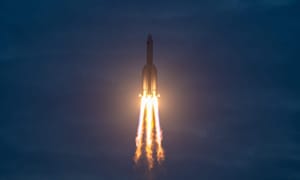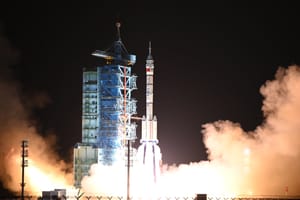
Disclaimer: Translations from Chinese in this article may not be entirely accurate.
China currently has plans to land a crew on the surface of the Moon by 2030 but how do they plan to achieve this goal? And what spacecraft and rockets will be used?
The goal was announced to the wider world online via Xinhua on their Weibo account back on the 12th of January 2023. The announcement reads as follows in English:
"The China Manned Space Engineering Office announced on the 12th a preliminary plan for China's manned moon landing, and plans to launch scientific exploration on the moon by 2030."
"At the 9th China (International) Commercial Space Summit Forum held in Wuhan on the same day, Zhang Hailian, deputy chief designer of the China Manned Space Engineering Office, stated that my country plans to achieve manned landing on the moon to carry out scientific exploration by 2030, and will explore afterwards. Build a lunar scientific research test station to carry out systematic and continuous lunar exploration and related technical test verification."
"It is understood that my country's preliminary plan for manned landing on the moon is to use two carrier rockets to send the lunar lander and the manned spacecraft to the earth-moon transfer orbit, the spacecraft and the lander rendezvous and dock in the orbit around the moon, and the astronauts enter from the spacecraft. Lunar lander. After that, the lunar lander will descend and land in a predetermined area of the lunar surface, and astronauts will land on the moon to carry out scientific investigation and sample collection. After completing the set mission, the astronauts will take the lander to orbit around the moon to rendezvous and dock with the spacecraft, and bring samples back to Earth on the spacecraft. In order to accomplish this task, Chinese researchers are developing the long March 10 carrier rocket, a new generation of manned spacecraft, lunar lander, lunar landing suit, manned lunar rover and other equipment."
The mission is widely believed to take place in 2029 to coincide with the 80th anniversary of the founding of the People's Republic of China, which occurred on the 1st of October 1949. The mission plan for the crewed landing is believed to be as follows:
The first Long March 10 will take off from the Wenchang Space Launch Site carrying the 'Chinese crewed lunar lander' to a trans-lunar trajectory. After the Long March 10 completes the trans-lunar burn the spacecraft will separate and spend the next few days flying towards the Moon.
Once near the Moon the 'Chinese crewed lunar lander' will light its propulsion modules engine to enter orbit of the Moon. The spacecraft will then wait in lunar orbit for the 'next-generation crewed spacecraft'
A few days later a second Long March 10 will take off from the Wenchang Space Launch Site carrying three crew taikonauts aboard the 'next-generation crewed spacecraft' to a trans-lunar trajectory. After the Long March 10 completes the trans-lunar burn, the spacecraft will fly towards the Moon over the next few days.
Once the 'next-generation crewed spacecraft' is near the moon it will light its engines to enter orbit of the Moon. The spacecraft will then rendezvous with the 'Chinese crewed lunar lander' in orbit. After rendezvous, the two spacecraft will dock allowing the crew to move between the two spacecraft.
After checkouts of the two spacecraft are completed in lunar orbit the two spacecraft will undock with two crew being headed for the surface and one remaining on orbit. It is believed the propulsion module will still be attached to the 'Chinese crewed lunar lander' and will perform its final burn to send the spacecraft bound for the surface.
After a predetermined coast phase the 'Chinese crewed lunar lander' will separate from the propulsion module and light its engines for landing. The exact landing profile is unknown but it is likely to be similar to the Lunar Module of the Apollo program.
Once the 'Chinese crewed lunar lander' has confirmed its engines shut off and has soft contact with the lunar surface the crew will prepare to exit the spacecraft. The two taikonauts will exit the spacecraft a few hours after the landing.

The two taikonauts will spend a believed eight hours outside on the lunar surface gathering various samples and deploying science equipment, including a rover to traverse large distances. After spending up to eight hours outside the two taikonauts will board the 'Chinese crewed lunar lander' and safely store the gathered samples.
Once the two taikonauts are prepared to leave the lunar surface the 'Chinese crewed lunar lander' will relight its engines and return to lunar orbit where it will rendezvous with the 'next-generation crewed spacecraft'. The two spacecraft will once again dock where the crew will transfer themselves and lunar samples out of the lander.
After the samples are removed from the 'Chinese crewed lunar lander' and any planned cargo is transferred between the two spacecraft they will undock for the second and final time. The 'next-generation crewed spacecraft' will then move to a safe distance away before it lights its engines again to carry the three taikonauts aboard on a trajectory back to Earth.
The three crew members will then spend a few days inside the 'next-generation crewed spacecraft' as it travels back to Earth.
At a predetermined point before entry into Earth's atmosphere the capsule of the 'next-generation crewed spacecraft' will separate from its service module and orient itself for entry. Once through the heat of entry into Earth's atmosphere at speeds of over 11,000 meters a second, or roughly 24,500 miles per hour, the capsule will deploy its parachutes to either touchdown on land or splashdown at sea for recovery of the three taikonauts and the lunar samples.
Once the crew is recovered safely the mission is complete.
Where is the mission hardware now?
According to the China Academy of Space Technology, back in May, hardware for the mission has been in development for the mission since 2017. Notably the YF-100 engines which will be used in the Long March 10. The engines have currently flown on the Long March 5, Long March 6, Long March 7, and Long March 8 to prove their in-flight reliability.
An upgraded version is needed for the Long March 10 in its current design. The upgraded versions are the YF-100K and the YF-100M. Twenty-one YF-100K engines will power the Long March 10 for its first stage and boosters. Two YF-100M engines will power the second stage of the Long March 10 to carry it almost all the way to orbit.

The upgraded YF-100 engines have been performing tests successfully since September of 2022, including restarts on the stands with no change of hardware needed. The YF-100K is reported to be successfully hitting its performance targets. The thrust of the YF-100K and YF-100M will be roughly 130 tons of thrust at sea level. A single YF-100K is believed to have been tested successfully for over three-thousand three-hundred seconds as of May 2023.
The Long March 10 is also going to utilize an upgraded YF-75D engine which has been flying on the Long March 5 to prove its in-flight reliability. The upgraded engine is called the YF-75E and will power the third stage of the Long March 10. Three YF-75E engines will send the third stage and its payload toward the Moon or deep space.

The YF-75E has been performing tests successfully since June of 2022. Since October of 2022, the YF-75E has run over ten-thousand seconds of test runs. The YF-75E will have a higher specific impulse, thrust, and larger nozzle to enable the lunar mission on the Long March 10.
The Long March 10 has also had structural test hardware and tanks being built since late 2019. Teams have constructed fuel tanks to store rocket-grade kerosene and liquid oxygen which have successfully passed pressure and load tests since 2020. The third stage liquid hydrogen and liquid oxygen tank has also passed 'flight-like' load tests in late 2022.

The Long March 10 is reportedly currently on track for its maiden flight in 2027 with test flights to low Earth orbit and beyond scheduled for 2027 and 2028.

The 'next-generation crewed spacecraft' has been in development since the mid-2010s and has flown two test flights to low Earth orbit. In 2016 the spacecraft flew as a smaller-scale prototype atop of a Long March 7 to prove the required technologies work in space and to survive entry into Earth's atmosphere. In 2020 the spacecraft flew atop of a Long March 5B to test its avionics and in-space performance over three days. The second flight ended when the capsule touched down in the People's Republic of China successfully testing an airbag to soften the landing and its heat shield technology.
Information about progress on the 'Chinese crewed lunar lander' is closely guarded by both the China Academy of Space Technology and the China Manned Space Agency. However, components are being tested for the crewed lunar mission at their respective facilities.
What needs to happen before the mission?
One of the biggest milestones that needs to be completed successfully prior the the crewed lunar landing mission is a test of the Long March 10 in its three-stage configuration with the two boosters, also known as the lunar mission configuration. It is unconfirmed currently but a test of the lander in low Earth orbit will potentially occur in the late-2020s. More tests of the 'next-generation crewed spacecraft' will likely occur, potentially flying on the two-stage configuration of the Long March 10.
China is currently aiming to land two probes at the lunar south pole, which may be one of the potential landing sites for the crewed mission, called Chang'e 7 and Chang'e 8. Chang'e 7 will consist of an orbiter, lander, rover, and 'hoping' probe with Chang'e 8 likely consisting of the same. Chang'e 7 is notably looking to test laser communication, similar to NASA's Psyche spacecraft, as well as photograph the lunar surface at a resolution of 30 centimeters per pixel. Chang'e 7 is currently planned to launch in 2026 with Chang'e 8 planned for 2028 but both could launch sooner.
China is also looking to expand its communications capabilities around the Moon with more relay satellites. China has had the Queqiao relay satellite in orbit of the Moon since 2018 and plans to have Queqiao-2 enter operation around the Moon in early 2024.
So what is the 'next-generation crewed spacecraft'?

The 'next-generation crewed spacecraft' is China's in-development crewed spacecraft for low Earth orbit and lunar orbit operations. The spacecraft is believed to be able to carry up to seven taikonauts to low Earth orbit or three taikonauts to lunar orbit.
The spacecraft will have two large solar panels to power its systems and life support for the crew. It is believed the spacecraft will weigh 26,000 kilograms fully fuelled for a lunar mission. It is currently unknown what changes will be made for the low Earth orbit version of the 'next-generation crewed spacecraft'.
The 'next-generation crewed spacecraft' consists of a command module, to house the crew, and a service module, to power the spacecraft and allow it to enter lunar orbit.
The China Manned Space Agency is believed to have been open to either suggestions or a naming competition to name the 'next-generation crewed spacecraft'. The name should be revealed in the near future.
And what is the 'Chinese crewed lunar lander'?

The 'Chinese crewed lunar lander' is China's in-development lunar lander spacecraft for lunar landing missions. The spacecraft will be able to carry two taikonauts to and from and lunar surface in its current design.
The spacecraft will have two large circular solar panels to power its systems and life support for the crew. The spacecraft is believed to weigh 26,000 kilograms fully fuelled with its propulsion module.
The 'Chinese crewed lunar lander' consists of a lander module, to perform lunar landings and house the crew for their mission, and the propulsion module, which will allow the spacecraft to enter lunar orbit.
The China Manned Space Agency is believed to have also been open to either suggestions or a naming competition to name the 'Chinese crewed lunar lander'. The name should also be revealed in the near future.
Finally, what is the Long March 10?
The Long March 10 is a three-stage rocket in development by the China Academy of Launch Vehicle Technology. The rocket plans to burn rocket-grade kerosene and liquid oxygen in its boosters, first, and second-stage. The third-stage currently plans to burn liquid hydrogen and liquid oxygen.
The Long March 10 is currently expected to make its maiden flight in 2025.
The Long March 10's planned payload is believed to be 70,000 kilograms to low Earth orbit, or 27,000 kilograms to a trans-lunar injection.

The boosters currently plan to use seven YF-100K engines generating 892 tons of thrust burning rocket-grade kerosene and liquid oxygen. The combined thrust of the two boosters is 1785 tons of thrust. The expected burn time is currently unknown.
The first-stage is currently planning to use seven YF-100K engines generating 892 tons of thrust burning rocket-grade kerosene and liquid oxygen. Once again the expected burn time is also unknown currently.
The second-stage is currently planning to use two YF-100M engines generating 298 tons of thrust burning rocket-grade kerosene and liquid oxygen. The burn time of the second-stage is also unknown currently.
The third-stage is currently planning to use three YF-75E engines generating 28 tons of thrust burning liquid hydrogen and liquid oxygen. The burn time of the thrid-stage is currently unknown.
The Long March 10 is expected to weigh up to 2,189,000 kilograms while fully fuelled and be up to 93.2 meters tall when on the launch pad.
There are also plans to recover the boosters of the Long March 10 by making the engines restartable and adding grid fins to guide the boosters. The Long March 10 currently does not plan to have landing legs to land and will instead be caught on 'tensioned wires' with 'hooks' on the booster. This is likely to be downrange on a ship.
Does China have future lunar plans?
China currently plans to build a research base on the lunar south pole. This is a joint project between China, Russia, South Africa, Azerbaijan, Egypt, Belarus, Pakistan, and Venezuela.
The project is called the International Lunar Research Station and aims to be built in the early 2030s. The project is believed to be open to any country seeking to join however some believe that it exists in opposition to the United States led Artemis Accords.
What are taikonauts?
The word taikonaut has been used lots in this article so a small explanation of the word is necessary. Taikonaut is what China calls its astronauts, such as the country's first taikonaut Yang Liwei who flew into space in 2003.
The word comes from a combination of the Chinese word for outer space, taikong, and the suffix, naut.
To date, China has flown twenty taikonauts to space, eighteen men and two women.



